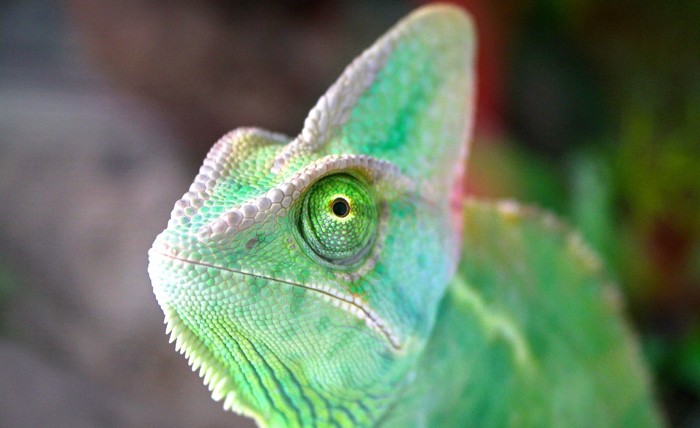Veiled Chameleon (Chamaeleo calyptratus)
Natural history
Taxonomy
Class: Reptilia
Order: Squamata
Family: Chamaeleonidae
Color and Size
Males are brightly colored, ranging from blue-green to green or yellow in appearance.
Males are 18-24 inches (45-60 cm) long, while female “veileds” typically measure up to 14 in (35 cm) long.
Diet
Veiled chameleons are typically fed a variety of gut-loaded insects such as crickets, mealworms, superworms, waxworms, grasshoppers, silkworms, and Madagascar roaches of appropriate size. Veiled chameleons also enjoy blossoms and leaves such as hibiscus, dandelions, ficus, romaine, and escarole.
Dust the non-breeding adult’s diet with a calcium carbonate or calcium gluconate supplement once weekly. Calcium supplements should be devoid or low in phosphorus with a minimum Ca:P ratio of 2:1. Avoid products containing Vitamin D as this can lead to toxicity. A general vitamin/mineral supplement may also be offered once weekly.
For more information, download the client handout: Feeding Insect Eating Reptiles.
Husbandry
| Temperature | Maintain a temperature gradient of 70-95°F (20-35°C) using an overhead radiant heat source. Provide a 10-15°F (5-8°C) drop in temperature at night. |
| Humidity/water | Maintain 40-60% relative humidity. Offer water either by misting the plants every 4-8 hours or with an automatic watering system. |
| Cage size and design | Minimum cage size is 2 x 2 x 3 feet (0.6 x 0.6 x 0.9 m) but much larger is recommended. Plastic-coated wire-welded mesh enclosures serve well. House adults in a large, vertical wire enclosure. |
| Cage furniture/supplies | Provide multiple branches or twigs for climbing, potted plants (e.g. Ficus benjamina or hibiscus) to provide visual security, and a full-spectrum light source for normal absorption of dietary calcium. |
| Social structure | A mixed pair or two females can usually coexist well in a large cage with visual barriers. |
Lifespan
Females typically live 3-5 years; the average male lifespan is 4-6 years. may live up to 6-7 years.
Sexual maturity is reached between 4-8 months.
Anatomy/ physiology
Dermatologic:Some chameleon species, including the Veiled, have “chromatophores” or specialized cells in the skin that allow color change.
Musculoskeletal:Chameleons are didactyl: five toes are fused into groups of two laterally and three medially giving the foot a mitten-like appearance.Gastrointestinal:
- The tongue is a complicated structure that sits within a structure at the base of the oral cavity. The tip of the tongue is normally darker where the taste buds are found.
- Acrodont dentition: Teeth are not set in sockets, but instead are weakly attached to the jawbone surface.
- Lizards have incomplete tracheal rings.
Ophthalmic:The upper and lower eyelids are fused with only a pinhole opening for the pupil. The eyes can rotate and focus separately.Urogenital:
- A renal portal system is present.
- Like many lizards, the chameleon has a thin-walled bladder.
- The male copulatory organ is the hemipenes.
Sexual dimorphism:Males are larger than females (see Size above).
The prominent casque on top of the head is also taller in males, and males have distinct calcars or heel spurs that are apparent at birth.
Chameleons are most comfortable when allowed to perch on a wooden dowel or finger. When manual restraint is necessary, place one hand underneath to allow the chameleon to grip with its feet. Place the palm of your other hand over the chameleon’s back. Grasp the head behind the eyes with the thumb and index finger.
Venipuncture
Ventral tail (coccygeal) vein
(The ventral abdominal vein is not easily found).
Preventive medicine
Regular physical examination
Fecal parasite testing
Quarantine
Use ivermectin with caution; toxicity has been reported. Avoid use in debilitated animals.
Important medical conditions
- Egg binding
- Nutritional secondary hyperparathyroidism (metabolic bone disease)
- Ophthalmic disease
- Stomatitis, periodontal disease
**Login to view references**
References
References
Bartlett PB, Griswold B, Bartlett RD. Reptiles, Amphibians, and Invertebrates: An Identification and Care Guide, 2nd ed. Hauppage, NY: Barron’s Educational Series; 2010.
Coke R. Medicine & surgery of Old World chameleons. Proc Western Veterinary Conference 2004.
Coke R. Medical management of chameleons. Proc Mid-Western Exotic Animal Med Conf. 2000. Pp. 24-28.
De Vosjoli P. Care and Breeding of Chameleons (Herpetocultural Library). Singapore: Advanced Vivarium Systems, inc; 1995.
Hoby S, Wenker C, Robert N, et al. Nutritional metabolic bone disease in juvenile Veiled chameleons (Chamaeleo calyptratus) and its prevention. J Nutr 140(11):1923-1931, 2010.
Pollock C. Basic information sheet: Veiled chameleon. May 17, 2011. LafeberVet Web site. https://lafeber.com/vet/basic-information-for-veiled-chameleon/
